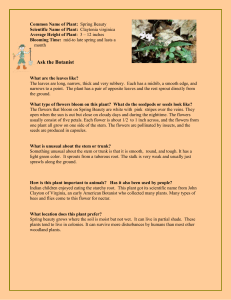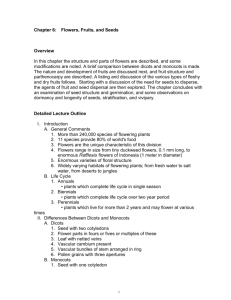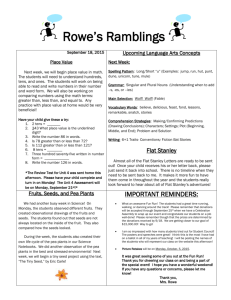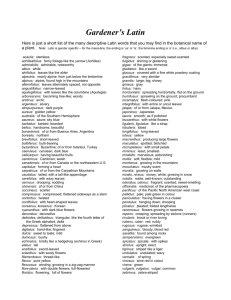Invasives Flashcard.xps
advertisement
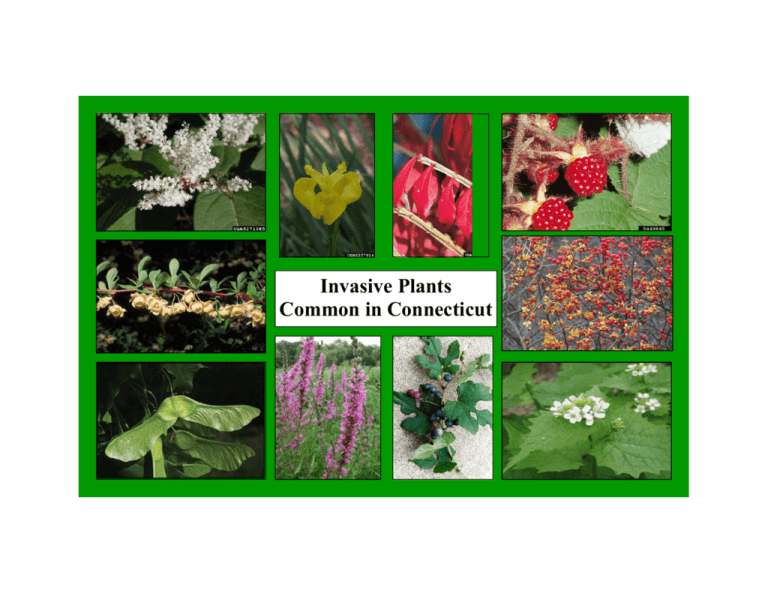
Invasive Plants Common in Connecticut Norway Maple Scientific Name: Acer platanoides L. Origin: Europe & Asia Ecological Threat: Forms monotypic populations by displacing native trees, shrubs, and herbaceous understory plants. Once established, it creates a canopy of dense shade that prevents regeneration of native seedlings. Description/Biology: Plant: broad deciduous tree up to 90 ft. in height with broadly-rounded crown; bark is smooth at first but becomes black, ridged and furrowed with age. Leaves: paired, deciduous, dark green, palmate (like a hand), broader across than from base to tip, marginal teeth with long hair-like tips. Flowers, fruits and seeds: flowers in spring, bright yellow-green; fruits mature during summer into paired winged “samaras” joined broadly at nearly 180° angle; milky sap will ooze from cut veins or petiole. Similar Species: Other maples including sugar maple (Acer saccharum) and red maple (Acer rubrum). Distinguish Norway by milky white sap, broad leaves, hair-like leaf tips, samara wings straight out, yellow fall foliage. Native Alternatives: Native maples like sugar maple (Acer saccharum) and red maple (Acer rubrum) Tree of Heaven Scientific Name: Ailanthus altissima (Mill.) Swingle Origin: Central China Ecological Threat: Fast-growing tree and prolific seeder, that can take over sites, replacing native plants and forming dense thickets. Also, produces chemicals that prevent the establishment of other plant species nearby. Description/Biology: Plant: deciduous tree that can reach 80 feet in height. Smooth stems with pale gray bark and twigs which are light chestnut brown. All parts of the tree have a nutty or burned nut odor. Leaves: large compound leaves are 1-4 ft. in length, alternate, and composed of 10-41 smaller leaflets. Each leaflet has one or more glandular teeth along the lower margin. Flowers, fruits and seeds: flowers occur in large terminal clusters and are small and pale yellow to greenish. Flat, twisted, winged fruits are produced on female trees in late summer to early fall. Similar Species: Native sumacs and trees like ash, hickory, black walnut, and butternut can be distinguished by having completely serrated leaf margins. Native Alternatives: Staghorn sumac (Rhus typhina), smooth sumac (Rhus glabra), black walnut (Juglans nigra), and hickories (Carya spp.). Garlic Mustard Scientific Name: Alliaria petiolata (M. Bieb.) Cavara & Grande Origin: Europe Ecological Threat: Many native wildflowers on which wildlife depend complete their life cycles in the springtime in the same habitat as garlic mustard and once it is introduced into an area, garlic mustard outcompetes native plants by aggressively monopolizing light, moisture, nutrients, soil, and space. Description/Biology: Plant: cool season biennial herb.1styear plants appear as a rosette and mature flowering plants reach from 2 to 3 1/2 ft. in height. Leaves: stalked, triangular to heart-shaped, coarsely toothed leaves that give off an odor of garlic when crushed. Flowers, fruits and seeds: button-like clusters of small white flowers, each with four petals in the shape of a cross. Produce erect, slender pods that become shiny black when mature. Stalks of dry, pale brown viable seedpods remain through summer. Similar Species: Toothworts (Cardamine spp.), early saxifrage (Saxifraga virginiensis) Native Alternatives: Rue-anemone (Thalictrum thalictroides), cut-leaved toothwort (Cardamine concatenata), bloodroot (Sanguinaria canadensis), wild ginger (Asarum canadense) Porcelainberry Scientific Name: Ampelopsis brevipedunculata (Maxim.) Trautv. Origin: NE Asia-China, Korea, Japan, & Russian Far East Ecological Threat: Vigorous invader of open and wooded habitats. Grows and spreads quickly in areas with high to moderate light and climbs over shrubs and other vegetation, shading out native plants. Description/Biology: Plant: deciduous, woody, perennial vine that twines with non-adhesive tendrils that occur opposite the leaves. Leaves: alternate, broadly ovate with a heart-shaped base, palmately 3-5 lobed or more deeply dissected, and have coarsely toothed margins. Flowers, fruits and seeds: inconspicuous, greenish -white flowers and colorful fruits, changing from pale lilac, to green, to a bright blue. Similar Species: Often confused with grape in genus Vitis, but the pith of porcelainberry is white (grape – brown), the bark has lenticels (grape does not), and the bark does not peel (grape bark peels or shreds). Native Alternatives: Native vines like trumpet honeysuckle (Lonicera sempervirens) Japanese Barberry Scientific Name: Berberis thunbergii DC. Origin: Japan Ecological Threat: Forms dense stands in natural habitats and alters soil PH, nitrogen levels, and biological activity in the soil. Studies are looking into a connection between tick populations and Japanese barberry. Description/Biology: Plant: dense deciduous, spiny shrub that grows 2 to 8 ft. high. The branches are brown, deeply grooved, somewhat zig-zag in form and bear a single very sharp spine at each node. Leaves: small (1/2 to 1 1/2 inch), oval to spatula-shaped, green, bluishgreen, or dark reddish purple. Flowers, fruits and seeds: pale yellow flowers about 1/4 in. across hang in umbrella-shaped clusters of 2-4 each along the length of the stem. Fruits are bright red berries about 1/3 in. long that are born on narrow stalks. Fruits persist in winter. Similar Species: Invasive common barberry (Berberis vulgaris) Native Alternatives: Northern bayberry (Morella pensylvanica), ink-berry (Ilex glabra), winterberry (Ilex verticillata), arrowwood (Viburnum dentatum), and mountain laurel (Kalmia latifolia). Oriental Bittersweet Scientific Name: Celastrus orbiculatus Thunb. Origin: Eastern Asia, Korea, China, and Japan Ecological Threat: Vigorously growing vine that climbs over and smothers vegetation. When it climbs high up in trees, the increased weight can lead to uprooting and blow-overs during high winds and heavy snowfalls. Description/Biology: Plant: deciduous woody perennial plant which grows as a climbing vine. Leaves: alternate, glossy, nearly as wide as they are long (round), with finely toothed margins. Flowers, fruits and seeds: female plants produce clusters of small greenish flowers in axillary clusters & each plant can produce large numbers of fruits and seeds. Fruits are three-valved, yellow, globular capsules that at maturity split open to reveal three red-orange fleshy fruits. Similar Species: American bittersweet (Celastrus scandens) looks similar but produces flowers and fruits in single terminal panicles at the tips of the stems. Also, the leaves are twice as long as wide and are tapered at each end. Hybrids do occur. Native Alternatives: American bittersweet (Celastrus scandens), trumpet honeysuckle (Lonicera sempervirens) Autumn Olive Scientific Name: Elaeagnus umbellata Thunb. Origin: Eastern Asia Ecological Threat: A rapid grower and prolific seed producer, it outcompetes and displaces native shrubs reducing floral and habitat diversity. As a nitrogen fixer, it can alter nutrient cycle dynamics and change soil suitability for other shrub species. Description/Biology: Plant: small, spiny deciduous shrub-like tree capable of reaching 20 ft. in height. Leaves: alternate oval leaves with silvery undersides. The leaves are simple and lack marginal teeth, but the margins are often crisped or wavy. Flowers, fruits and seeds: small, yellowish-white flowers reach the peak of bloom around mid-May and are highly fragrant. The fleshy fruits are brown at 1st and mature to a reddish hue with small metallic dots. Similar Species: Russian olive (Elaeagnus angustifolia) which is also invasive is similar in appearance, but its leaves are silvery on both sides and its fruits are yellow. Native Alternatives: Red Chokeberry (Aronia arbutifolia), Winterberry (Ilex verticillata), Silky Dogwood (Cornus amomum) Winged Euonymus Scientific Name: Euonymus alatus (Thunb.) Sieb. Origin: Northeastern Asia, Japan and Central China Ecological Threat: Forms dense thickets, displacing many native woody and herbaceous plant species. Description/Biology: Plant: deciduous shrub that averages 6 to 9 ft. in height but is capable of reaching 15 ft. Has corky-winged green and brown twigs. Leaves: opposite, simple, elliptical toothed leaves which turn scarlet in autumn. Flowers, fruits and seeds: fruit is a cluster of pods, usually four, which are quite showy. These purple fruits split open when ripe revealing the bright red inner parts. Similar Species: Other species of euonymus and saplings of native sweetgum (Liquidambar styraciflua) which also have winged stems. Native Alternatives: Red Chokeberry (Aronia arbutifolia), Winterberry (Ilex verticillata), Highbush Cranberry (Viburnum triobum), Silky Dogwood (Cornus amomum) Yellow Flag Iris Scientific Name: Iris pseudacorus L. Origin: Eurasia Ecological Threat: Spreads rapidly on shorelines and in wetlands and can out-compete native wetland plants including two native iris species and also appears to speed up marsh degradation. The rhizome mat prevents germination and seedling growth of other plant species including arrow arum (Peltandra virginica), which is an important duck food. Description/Biology: Plant: perennial that grows to a height of 1-3 ft. and produces thick pink-fleshed rhizomatous roots in dense mats. It is the only yellow iris likely to be found growing wild. Leaves: grassy or sword -like leaves. Flowers, fruits and seeds: showy, lemoncolored flowers that have three recurving sepals with broad blades that abruptly contract at the base and three erect, spoon-shaped petals. Fruits are ovoid and contain several large seeds per capsule. Similar Species: When not in bloom native blue flag iris (Iris versicolor) and native cattails (Typha spp.) Native Alternatives: Native blue flag iris (Iris versicolor), marsh marigold (Caltha palustris) European Privet Scientific Name: Ligustrum vulgare L. Origin: Europe & northern Africa Ecological Threat: Can tolerate a wide range of conditions and form dense thickets that shade out and exclude native understory species. Description/Biology: Plant: semi-evergreen shrub or small tree that grows to 20 ft. in height. Trunks usually occur as multiple stems with many long, leafy branches. Leaves: opposite and lanceolate. Flowers, fruits and seeds: flowering occurs from April to June, when panicles of white to cream flowers develop in terminal and upper axillary clusters. Spherical fruits begin green and ripen to a dark purple to black color and persist into winter. Similar Species: Other privets including Border privet (Ligustrum obtusifolium) and California privet (Ligustrum ovalifolium) both of which are invasive. They can only be positively identified when in flower. Native Alternatives: Arrowwood (Viburnum dentatum), Inkberry holly (Ilex glabra), Highbush blueberry (Vaccinium corymbosum), Japanese Honeysuckle Scientific Name: Lonicera japonica Thunb. Origin: Eastern Asia Ecological Threat: Invades a wide variety of habitats and it can girdle small saplings by twining around them. It can also form dense mats in canopies of trees, shading everything below. Description/Biology: Plant: woody perennial, evergreen to semi-evergreen vine that can be found either trailing or climbing to over 80 ft. in length. Young stems may be pubescent while older stems are smooth. Leaves: opposite, pubescent, oval, and 1-2.5 in. long. Margins are usually entire but young leaves may be lobed or toothed. Flowers, fruits and seeds: Flowers are showy, fragrant, tubular, and whitish-pink. They form in the axils of the leaves. The flowers turn cream-yellow as they age. The fruit is small, shiny, and globular and turn from green to black as they ripen. Similar Species: Native trumpet honeysuckle (Lonicera sempervirens) and shrub honeysuckles Native Alternatives: Trumpet honeysuckle (Lonicera sempervirens) Morrow’s Honeysuckle Scientific Name: Lonicera morrowii A. Gray Origin: Eastern Asia Ecological Threat: Readily invades open woodlands, old fields, and disturbed sites. Spreads rapidly and can form a dense understory thicket which can restrict native plant growth and tree seedling establishment. Description/Biology: Plant: multi-stemmed, upright, deciduous shrub that grows up to 8 ft. tall. The bark is light brown and often pubescent on young stems. Stems are hollow. Leaves: grayish-green leaves that are opposite, round, 2-3 in. long, and hairy underneath. Flowers, fruits and seeds: the white to creamcolored flowers are flagrant, paired, and tubular. The berries ripen to orange or red in color and often persist throughout the winter. Similar Species: Other bush honeysuckles including the invasive Amur honeysuckle (Lonicera maackii), the invasive Tartarian honeysuckle (Lonicera tartarica), and the invasive Belle honeysuckle (Lonicera x bella). There are also native bush honeysuckles like Fly honeysuckle (Lonicera canadensis). The invasive bush honeysuckles all have hollow pith and the natives have solid pith. Native Alternatives: Fly honeysuckle (Lonicera canadensis), Spicebush (Lindera benzoin), Red Chokeberry (Aronia arbutifolia), Winterberry (Ilex verticillata) Purple Loosestrife Scientific Name: Lythrum salicaria L. Origin: Eurasia; throughout Great Britain, and across central & southern Europe to central Russia, Japan, Manchuria China, southeast Asia and northern India. Ecological Threat: Adapts readily to natural and disturbed wetlands and outcompetes native grasses, sedges, and other higher quality sources of nutrition for wildlife. Description/Biology: Plant: erect perennial herb with a square, woody stem that can grow from four to ten ft. high. Mature plants can have from 30 to 50 stems arising from a single rootstock. Plants are usually covered by a downy pubescence. Leaves: lance-shaped, stalkless, and heart-shaped or rounded at the base. Flowers, fruits and seeds: showy display of magenta-colored flower spikes. Flowers have five to seven petals. Similar Species: Winged loostrife (Lythrum alatum) which is an endangered plant in CT. It is shorter in stature (1-2.5 ft. tall). The leaves of winged loosestrife are alternately arranged, except for the lowest ones on the plant and the flowers are solitary in the upper axils Native Alternatives: Blue vervain (Verbena hastata), Cardinal flower (Lobelia cardinalis), Fireweed (Epilobium angustifolium) & Purple coneflower (Echinacea purpurea) Japanese Stilt Grass Scientific Name: Microstegium vimineum (Trin.) A Camus Origin: Japan, Korea, China, Malaysia, and India Ecological Threat: Well adapted to low light conditions and threatens native plants and natural habitats in open to shady, and moist to dry locations. It spreads to form large patches displacing native species and may change soil chemistry. Description/Biology: Plant: annual grass that reaches heights of 2-3 1/2 ft. and spreads during the summer and fall by rooting at stem nodes that touch the ground. Leaves: pale green, lance-shaped, asymmetrical, 1-3 in. long, with a distinctive shiny midrib. Flowers, fruits and seeds: slender stalks of tiny flowers are produced in late summer and dry fruits called achenes are produced soon afterwards. Individual plants may produce 100-1,000 seeds and they remain viable in the soil for five or more years. Similar Species: Native white grass (Leersia virginica), invasive hairy jointgrass (Arthraxon hispidus) Native Alternatives: Big bluestem (Andropogon gerardii), Switchgrass (Panicum virgatum) Common Reed Scientific Name: Phragmites australis (Cav.) Trin. ex Steud. Origin: Eurasia & Africa Ecological Threat: forms dense thickets in or near shallow water that displace native plants, alter hydrology, and block sunlight to the aquatic community. Description/Biology: Plant: tall, perennial grass that can grow to heights of 15 ft. or more. Broad, pointed leaves arise from thick, vertical stalks. Leaves: 6-23 in. long, 0.42.4 in. wide, flat and smooth. Flowers, fruits and seeds: flower heads are dense, fluffy, gray or purple in color and 6-16 in. long. The seeds are brown, light weight and about 0.3 in. long. Similar Species: Research is being done on the presence of a native phragmites Native Alternatives: Big bluestem (Andropogon gerardii), pussy willow (Salix discolor), smooth cordgrass (Spartina alterniflora), switchgrass (Panicum virgatum) Japanese Knotweed Scientific Name: Polygonum cuspidatum Siebold & Zucc. Origin: Eastern Asia Ecological Threat: Invades disturbed areas with high light, such as roadsides and stream banks. Reproduction occurs both vegetatively (rhizomes) and seeds, making it extremely hard to eradicate. Dense patches shade and displace other plant life and reduce wildlife habitat. Description/Biology: Plant: dense growing shrub reaching heights of 10 ft. The semi-woody stem is hollow with enlarged nodes. Leaves: alternate, 6 in. long, 3-4 in. wide and broadly ovate. Leaf tips are abruptly pointed and the bases are blunt. Flowers, fruits and seeds: small, greenish-white flowers develop in long panicles in the axils of the leaves. The fruits are papery and winged, containing shiny, black, three angled seeds. Similar Species: Giant knotweed (Polygonum sachalinense) which is listed as potentially invasive in CT Native Alternatives: New England Aster (Aster novaeangliae), sweet joe pye-weed (Eupatorium purpureum) Mile-A-Minute Weed Scientific Name: Polygonum perfoliatum L. Origin: Eastern Asia & Philippines Ecological Threat: Invades open disturbed areas such as fields, forest edges, roadsides, ditches, and stream banks. Its rapid growth allows it to cover existing vegetation and restrict light. Dense mats can restrict establishment of new vegetation. Description/Biology: Plant: herbaceous, annual vine with delicate stems that are reddish, highly branched and covered with small, curved spines. There are also circular, leafy structures that surround the stem at the base of the petioles. Leaves: alternate, triangular, light green, 1-3 in wide and barbed on the undersurface. Flowers, fruits and seeds: The flowers are small, white, inconspicuous and arise from the circular leafy structures. The fruit are metallic blue and segmented with each segment containing a single black or reddish black seed. Similar Species: Tearthumbs (Polygonum arifolium & Polygonum sagittatum), hedge bindweed (Calystegia sepium), which are all native. Native Alternatives: Native vines like certain tearthumbs or trumpet honeysuckle (Lonicera sempervirens) Black Locust Scientific Name: Robinia pseudo-acacia L. Origin: Native to Southern Appalachians, the Ozarks, and other portions of the Midsouth Ecological Threat: Expands readily into areas where their shade reduces competition from other plants. Also, their large, fragrant blossoms compete with native plants for pollinating bees. Description/Biology: Plant: fast-growing deciduous tree that can reach 40 to 100 ft. in height. Mature tree bark is dark brown and deeply furrowed, with flat-topped ridges. Seedlings and sprouts grow rapidly and are easily identified by long paired thorns. Leaves: alternate along stems and composed of seven to twenty-one smaller leaflets. Leaflets are oval to rounded in outline, dark green above and pale beneath. Flowers, fruits and seeds: fragrant white flowers appear in drooping clusters and have a yellow blotch on the uppermost petal. Fruit pods are smooth, 2-4 in. long, and contain 4-8 seeds. Similar Species: Non-native honeylocust (Gleditsia triacanthos) Native Alternatives: Native deciduous trees like sugar maple (Acer saccharum), red maple (Acer rubrum), red oak (Quercus rubra), white oak (Quercus alba) Multiflora Rose Scientific Name: Rosa multiflora Thunb. Origin: Asia Ecological Threat: Forms impenetrable thickets in pastures, fields, and forest edges, restricts human, livestock, and wildlife movement and displaces native vegetation. Description/Biology: Plant: multi-stemmed, thorny, perennial shrub that grows up to 15 ft. tall with stems from green to red which are round in cross section and have stiff, curved thorns. Leaves: pinnately compound with 7-9 leaflets. Leaflets are oblong, 1-1.5 in. long and have serrated edges. Fringed leaf stalks distinguish it from most other rose species. Flowers, fruits and seeds: small, white to pinkish, 5 petaled flowers occur abundantly in clusters and the fruits are small, red rose hips that remain on the plant throughout the winter. Similar Species: Native woods’ rose (Rosa woodsii) and Carolina rose (Rosa carolina) Native Alternatives: Native shrubs like Arrowwood (Viburnum dentatum), Inkberry holly (Ilex glabra), Highbush blueberry (Vaccinium corymbosum) Wineberry Scientific Name: Rubus phoenicolasius Maxim. Origin: Japan, Korea, & China Ecological Threat: Vigorous grower that can form dense thickets covering large areas, displacing many native plants in the process. Description/Biology: Plant: mature plant has long stems that are upright and arching and covered in distinctive glandular red hairs and small spines. Leaves: three heart-shaped, serrated leaflets with purplish veins that are silvery white on the underside. Flowers, fruits and seeds: has small greenish flowers with white petals and reddish hairs and a very edible raspberry like fruit that is bright red and ripens during June and July. Similar Species: Red raspberry (Rubus idaeus), black raspberry (Rubus occidentalis), and blackberry (Rubus canadensis) Native Alternatives: Native raspberry and blackberry species listed above Additional Resources Invasive Plant Resources: • The Connecticut Invasive Plant Working Group (CIPWG) http://www.cipwg.uconn.edu/ • Invasive Plant Atlas of New England (IPANE) http://www.eddmaps.org/ipane/ • Invasive.org: Invasive and Exotic Species of North America http://www.invasive.org/ Native Plant Resources: • Connecticut Botanical Society (CBS) http://www.ct-botanical-society.org/ • New England Wildflower Society (NEWFS) http://gobotany.newenglandwild.org/ • Lady Bird Johnson Wildflower Center http://www.wildflower.org/collections/collection.php? collection=CT
